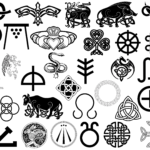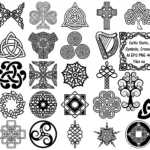Get ready to dive into the world of Celtic symbols, where each one has a special power and meaning. In this article, we’re going to explore the symbol for strength. It’s an ancient symbol that has been passed down through generations, and it still resonates with people today. We’ll take a look at where it came from, what it means, and how it’s still relevant in our modern lives. So, let’s dive in and discover the enduring strength of the Celtic symbol for might!
Celtic Symbol for Strength: A Timeless Embodiment of Resilience and Fortitude
The ancient Celts, renowned for their unwavering spirit and fierce warriors, left behind a profound legacy of symbolic imagery imbued with the essence of strength. These symbols, etched into the fabric of their culture, have endured through the ages, serving as potent reminders of the resilience and fortitude that lies dormant within us all.
The Mighty Dara Knot: A Shield of Unbreakable Bonds
Among the most enduring Celtic symbols of strength is the Dara Knot. Resembling an intricate shield, its interwoven lines evoke the interconnectedness of all things, reminding us that true strength is found not only within ourselves but in our unbreakable bonds to others. At its core lies the image of the mighty oak tree, deeply rooted and resilient, a testament to the enduring power of unity and support.
Ailm: The Tree of Unyielding Resistance
The Celtic alphabet, known as Ogham, holds within it the letter “A”, which forms the basis for the symbol Ailm. This symbol represents not only strength but also resilience and endurance. It is closely associated with the silver fir tree, known for its healing and restorative properties. Ailm serves as a reminder that strength is not merely physical or fleeting, but a deep-rooted quality that can withstand the storms of adversity.
The Ancient Celts: A People of Unmatched Fortitude
For the ancient Celts, these symbols of strength were not mere ornaments but a source of empowerment. Warriors carried them into battle, believing that their potent energy would shield them from harm and grant them the courage to face the fiercest of foes. They saw in these symbols a reflection of the indomitable spirit that had sustained their people for centuries.
Embracing the Celtic Symbol for Strength
In the present day, the Celtic symbol for strength continues to resonate with those who seek inner fortitude. By incorporating these symbols into our lives, whether through artwork, jewelry, or personal contemplation, we can connect to the wisdom and resilience of our ancestors. They remind us that even in the face of adversity, the strength to overcome lies within reach.
Tips for Harnessing the Power of the Celtic Symbol for Strength
- Wear a Dara Knot necklace or bracelet as a physical reminder of your innate resilience and power.
- Display Celtic knotwork art in your home or workspace to create a sense of grounding and stability.
- Meditate on the imagery of the Celtic symbol for strength, envisioning its intricate lines flowing through your being, empowering you with its ancient wisdom.
- Share the symbolism of these ancient symbols with others, spreading the message of resilience and fortitude.
Do you know that Celtic symbols are steeped in rich history and mythology? Explore the captivating world of Celtic symbols and uncover their enigmatic meanings and origins. Check This Out
What is the meaning behind the Ailm symbol in Celtic culture and lore?
Let’s dig deeper into the Ailm symbol, a powerful reminder from our Celtic ancestors about the strength and spirit within us.
The Ailm symbol is like a whisper from ancient trees, reminding us to stay strong like the pine and fir trees that endure storms. It’s a symbol of resilience, of knowing that no matter what life throws our way, we can keep going.
This symbol isn’t just a pretty face, it’s also a part of the ancient Ogham alphabet, where each letter is represented by a tree or plant. For the Ailm, it’s the pine or fir tree, standing tall and unshaken through harsh winds.
In Celtic lore, the Ailm is linked to the sun god Lugh, a master of arts, crafts, and skilled work. Just like Lugh, the Ailm encourages us to embrace our passions, even when the going gets tough, and to overcome any obstacles that stand in our way.
Through the centuries, the Ailm symbol has found its way into ancient Celtic jewelry, carved into stone, and woven into the heart of traditional art. It serves as a reminder that no matter what challenges we face, we have the strength and the spirit to persevere. By connecting with the Ailm symbol, we tap into the wisdom of our ancestors and find the resilience that lies within us.
In a nutshell:
- Ailm means strength, endurance, and inner power.
- It comes from the strong pine and fir trees that can handle tough times.
- Ailm teaches us to rise above challenges and start over.
- It’s a part of the Ogham alphabet, with each letter representing a plant or tree.
- You can find the Ailm symbol in Celtic jewelry, carvings, and art.
So, the next time you’re feeling like life’s got you down, remember the Ailm symbol and the resilience it represents. It’s a power waiting to be tapped into, a friend to guide you through tough times. Embrace the spirit of the Ailm and show the world what you’re made of!
How did Celtic warriors harness the power of strength symbols?
Tough as nails, Celtic warriors were always looking for an edge in battle. They found it in the ancient symbols they carried with them. These weren’t just cool designs, they were like lucky charms, giving them superhuman strength and protection.
Let’s take the Ailm symbol, for example. It looks like a big, strong oak tree or a rugged mountain. Warriors thought it gave them the same toughness and resilience. They’d gaze upon it before battle, feeling like they could crush anything.
The Triskele, with its three swirly bits, represented the never-ending circle of life. Warriors saw it as a symbol of their own determination. No matter how fierce the battle, they’d keep fighting because they knew they’d come out the other side stronger.
And then there’s the Dara Knot, a tangle of lines that looks like it’s impossible to untie. It was a reminder of the unbreakable bond between the warriors. They believed that by wearing this symbol, they were drawing strength from their entire clan.
These symbols weren’t just pretty decorations. Warriors believed they were like magic shields, protecting them from harm and giving them an extra boost of courage. So, next time you’re feeling a little weak, try looking at some Celtic symbols. Who knows, they might just give you the strength you need to conquer whatever life throws your way.
Symbol Powerhouse
| Symbol | What it did |
|---|---|
| Ailm | Made warriors as tough as trees and mountains |
| Triskele | Reminded warriors that they were immortal badasses |
| Dara Knot | Connected warriors to the strength of their entire clan |
Pros and Cons of Celtic Strength Symbols
Pros:
- Boost courage and resilience
- Protect from harm
- Create a sense of unity among warriors
Cons:
- May not actually give you magical powers (but who’s to say?)
- Can be a little awkward to wear if you’re not used to it
- Might make you look like a history nerd (but hey, embrace your inner warrior!)
What physical and mental strengths are represented by Celtic symbols?
Hey there! Let’s take a closer look at the fascinating world of Celtic symbols and how these intricate designs can inspire us to tap into our own inner strengths.
Physical Strength
Celtic symbols have always celebrated physical prowess. Here are a few examples:
- Ailm: Picture a mighty fir tree, its branches reaching up towards the sky. The Ailm symbolizes resilience and endurance, reminding us that we too can weather life’s storms.
- Bull: Strong as an ox! The bull represents raw power and determination. It encourages us to charge ahead with confidence and face challenges head-on.
- Lion: Now, imagine the roar of a lion. This symbol evokes courage and might, inspiring us to stand our ground and overcome obstacles.
- Bear: Like a giant teddy bear, the bear represents strength and stability. It reminds us to stay grounded even in the most turbulent times.
Mental Strength
Celtic symbols also speak to the power of the mind. Check these out:
- Triskelion: This three-legged symbol is all about balance, progress, and the circle of life. It encourages us to embrace change and find harmony within ourselves.
- Claddagh: A heart, a crown, and two hands—the Claddagh is a symbol of love, loyalty, and friendship. It reminds us of the importance of strong human connections.
- Celtic Knotwork: Those intricate patterns have a deeper meaning. They represent unity, eternity, and the interconnectedness of all things. They foster a sense of belonging and purpose within us.
These Celtic symbols are more than just pretty designs. They’re like ancient wisdom, guiding us to be strong, resilient, and connected. Whether you wear them as jewelry, display them as artwork, or simply meditate on their meanings, they can serve as a constant reminder of the power you hold within.
So, if life throws you a curveball, remember the strength of the Ailm. When you need a boost of confidence, channel the power of the bull or the lion. And when you’re feeling lost or disconnected, let the Triskelion, Claddagh, and Celtic knotwork guide you back to balance and unity.
By embracing the wisdom of our Celtic ancestors, we can harness the enduring power of these symbols and live more fulfilling lives.
FAQ
Q1: What is the most notable Celtic symbol for strength?
A1: The Dara Knot, also known as the Celtic Shield Knot, is the most recognized Celtic symbol of strength.
Q2: What qualities does the Ailm symbol represent?
A2: The Ailm symbol embodies strength, endurance, resilience, and other positive attributes.
Q3: How was the Ailm symbol used by Celtic warriors?
A3: Celtic warriors engraved the Ailm symbol on their shields to invoke protection, courage, and strength during battles.
Q4: What is the connection between the Ailm symbol and the fir tree?
A4: In Celtic mythology, the Ailm symbol is associated with the silver fir tree, which represents strength and resilience in the face of adversity.
Q5: Besides the Ailm and Dara Knot, are there other Celtic symbols of strength?
A5: Yes, there are various Celtic symbols associated with strength, including the Crann Bethadh (tree of life), triskelion (triple spiral), Claddagh ring, and Celtic knotwork.
- China II Review: Delicious Food & Speedy Service - April 17, 2025
- Understand Virginia’s Flag: History & Debate - April 17, 2025
- Explore Long Island’s Map: Unique Regions & Insights - April 17, 2025
















